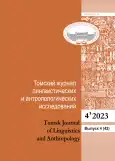Статья посвящена исследованию средств выражения цепочечного реципрока в русском жестовом языке. Типологические исследования реципрока показывают, что цепочечное значение может выражаться тем же показателем, что и прототипическое значение реципрока, а может передаваться специальным показателем. Русский жестовый язык, будучи языком, использующим визуальную модальность, может иметь специфические средства выражения данного значения, отличающиеся от способов выражения прототипического реципрока. Существующие исследования цепочечного реципрока в жестовых языках показывают, что для изображения цепочечных ситуаций активно используются классификаторные конструкции – морфологически сложные жесты, которые, по мнению некоторых исследователей, совмещают в себе лингвистический элемент и элементы жестикуляции. Следовательно, можно предположить, что семантика цепочечного реципрока будет выражаться в жестовых языках гораздо более подробно и иконично, чем в звуковых. Исследование проводилось с помощью корпусного метода и метода элицитации. Результаты исследования показали, что для обозначения пространственных цепочечных ситуаций в русском жестовом языке используется три типа классификаторных конструкций, которые применимы к более чем 15 классификаторным жестам, а также сочетания классификаторных конструкций, расположенные в строгом порядке. Рассматриваемые конструкции изображают процесс появления цепочки, факт ее существования в готовом виде и движение цепочки. При этом не все компоненты полученных классификаторных конструкций имеют свойство обязательности и системности, что ставит под сомнение их лингвистический статус. Обязательным для цепочечных конструкций является взаиморасположение ведущей и вспомогательной руки, а также траекторное движение, осуществляемое от начала к концу цепочки. Дополнительно, с помощью наличия/отсутствия редупликации, может передавать целостность/дискретность цепочки объектов. Вторичное движение и ориентация, передающие особенности, характер движения или конкретных объектов, обнаруживают значительную вариативность и высокую иконичность у разных информантов, а также необязательность. Это позволяет предположить, что данные характеристики могут относиться к изобразительному, жестикуляционному элементу классификаторных конструкций.
 9-22
9-22


 23-33
23-33


 34-44
34-44


 45-54
45-54


 55-64
55-64


 65-75
65-75


 76-83
76-83


 84-94
84-94


 95-102
95-102


 103-114
103-114


 115-126
115-126


 127-148
127-148


 149-158
149-158


 159-162
159-162












